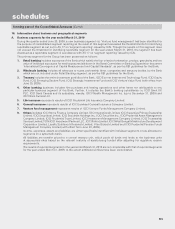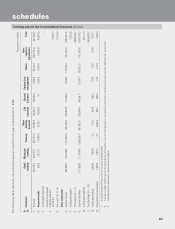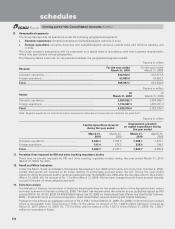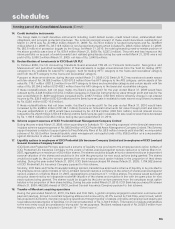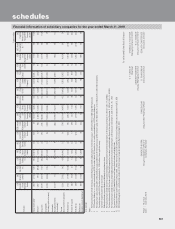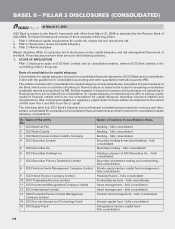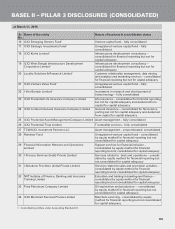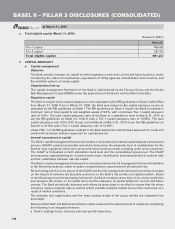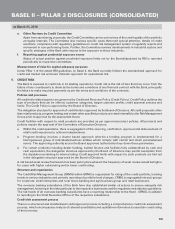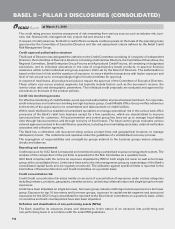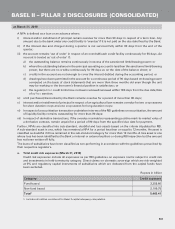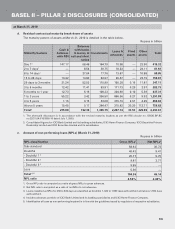ICICI Bank 2010 Annual Report Download - page 170
Download and view the complete annual report
Please find page 170 of the 2010 ICICI Bank annual report below. You can navigate through the pages in the report by either clicking on the pages listed below, or by using the keyword search tool below to find specific information within the annual report.
F90
BASEL II – PILLAR 3 DISCLOSURES (CONSOLIDATED)
a. Capital deficiencies
Majority owned financial entities that are not consolidated for capital adequacy purposes and for which the
investment in equity and other instruments eligible for regulatory capital status are deducted from capital,
meet their respective regulatory capital requirements at all times. There is no deficiency in capital in any of the
subsidiaries of the Bank at March 31, 2010. ICICI Bank maintains an active oversight on its subsidiaries through
its representation on their respective Boards. On a periodic basis the capital adequacy/solvency position of
subsidiaries (banking, non-banking and insurance subsidiaries), as per the applicable regulations, is reported
to their respective Boards as well as to the Board of the Bank.
b. Bank’s interest in insurance entities
The book value of the Bank’s total interest in its insurance subsidiaries at March 31, 2010, which is deducted
from capital for capital adequacy under Basel II is detailed in the following table.
Rupees in billion
Name of the entity Country of
incorporation Ownership
interest Book value of
investment
ICICI Prudential Life Insurance Company Limited India 73.89% 35.94
ICICI Lombard General Insurance Company Limited India 73.72% 10.96
The quantitative impact on regulatory capital of using risk weighted investments method versus using the
deduction method at March 31, 2010 is set out in the following table.
Rupees in billion
Method Quantitative impact
Deduction method 46.90
Capital at 9% based on risk weighted assets 4.22
2. CAPITAL STRUCTURE
a. Summary information on main terms and conditions/features of capital instruments
As per the RBI capital adequacy norms, ICICI Bank’s regulatory capital is classified into Tier-1 capital and
Tier-2 capital.
Tier-1 capital includes paid-up equity capital, statutory reserves, other disclosed free reserves, capital reserves
and innovative perpetual debt instruments (Tier-1 bonds) eligible for inclusion in Tier-1 capital that comply with
requirement specified by RBI.
Tier-2 capital includes revaluation reserves (if any), general provision and loss reserve, investment reserve,
upper Tier-2 instruments (upper Tier-2 bonds) and subordinate debt instruments (lower Tier-2 bonds) eligible
for inclusion in Tier-2 capital.
ICICI Bank and its subsidiaries have issued debt instruments that form a part of Tier-1 and Tier-2 capital. The terms
and conditions that are applicable for these instruments comply with the stipulated regulatory requirements and
where required an independent legal opinion has been obtained for inclusion of these instruments in capital.
Tier-1 bonds are non-cumulative and perpetual in nature with a call option after 10 years. Interest on Tier-1
bonds is payable either annually or semi-annually. These Tier-1 bonds have a step-up clause on interest payment
ranging up to 100 basis points.
The upper Tier-2 bonds are cumulative and have an original maturity of 15 years with call option after 10 years.
The interest on upper Tier-2 bonds is payable either annually or semi-annually. Some of the upper Tier-2 debt
instruments have a step-up clause on interest payment ranging up to 100 basis points.
The lower Tier-2 bonds (subordinated debt) are cumulative and have an original maturity between 5 to 15
years. The interest on lower Tier-2 capital instruments is payable quarterly, semi-annually or annually.
at March 31, 2010



